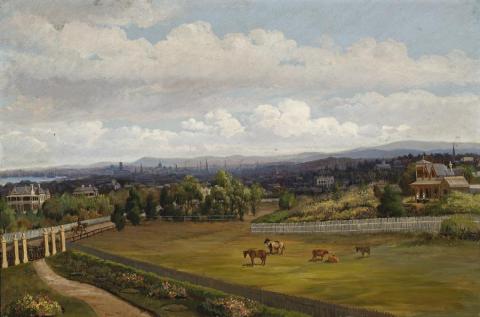EARLY VIEW OF PRAHRAN WITH CITY OF MELBOURNE IN THE DISTANCE, c.1885
Artist Unknown
oil on canvas
51.0 x 76.5 cm
The Berry Collection, Melbourne
Private collection, Victoria
The painting is dated c.1885, supported by an estate agent's folder printed by Sands & McDougall Limited, advertising early Melbourne properties. The folder includes a double-page colour lithograph of the same subject, with the added inscription of the name Wynnstay highlighting the double-storey property on the far right of the painting.
The Wynnstay mansion was built and owned c1879 by George William Taylor, real estate developer and former Mayor of Prahran. He purchased land on the northern fringes of Prahran when prices were low, subdivided, and with his profits bought more on low deposit, eventually controlling more than 35,000 acres including bayside tracts and land as far afield as Bacchus March and Lilydale.
Taylor was elected to Council in 1877 and served as Mayor of Prahran in 1884-5. The extensive grounds of the Wynnstay Estate fronted onto High Street, Orrong Road, Hampden Road, Wynnstay Avenue (today's Elgin Avenue), Auburn Grove and Avondale Road, and on 12 March 1887 the estate including the house and all its grounds was advertised for sale and subdivision. The house sold at auction and was tenanted for many years until its demolition in the mid-twentieth century.
At the far left of the painting is a double-storey Victorian home, Merville House, part of the Merville Estate, purchased in 1849 as Lot 53 at the Crown Land sales by Mrs Mary Chomley, widow of an Irish parson. Merville was named after Mary's cousin Lord Downes' estate near Dublin. Mary died in 1868 and the estate was subdivided, the house described in the auction notice as 'a very pretty three-floored chateau of stone and brick'.
Subdivision and sale of the estate was very slow, and in 1884 eleven 'elegant villa sites' were offered for sale through George W.Taylor as estate agent. The 1884 estate sale notice refers to the area as Highbury, Prahran, a likely concept by George Taylor who had come from Highbury, a small village in Yorkshire. In the following years the house had a number of owners.
It is possible that this painting was commissioned by George Taylor during his tenure as Mayor of Prahran in 1884-5 and that it was painted from the verandah of his neighbour David Barry's house Elgin, shown in the foreground of the painting, a vantage point which shows the extensive views from Taylor's estate, comprising Port Phillip Bay, the Macedon ranges in the distance, and overlooking Prahran, Toorak and Malvern. The skyline shows many church spires and local landmark buildings, including the Prahran Town Hall and its tower (built 1861) on the corner of Chapel Street and Greville Street, Government House (built 1876) and the Royal Exhibition Building (built 1880).
The relative position between the Wynnstay, Elgin and Merville estates as shown in the painting is further supported by a 1887 Real Estate notice for Merville. Alternatively, it is possible that the painting was commissioned by David M.Barry, owner of the grand double-storey Victorian mansion Elgin - still extant today and now called Elgin Hall at 21 Elgin Avenue, Prahran - built in 1883, originally its grounds stretched from Orrong Road to Hampden Road. During the early years of the twentieth century it was occupied by Hubert Cox and family, and in 1909 it became University College, later known as Hassett's College, which transferred later to Chapel Street.
In 1927, the year in which the property was subdivided, it was described as a mansion of twenty rooms, four bathrooms, a brick garage and stables. During the 1940s it was used and became known as the Elgin Hall Guest House, and in 1958 it was bought by the Catholic Church and used as the Hungarian Club Youth Hostel, called the Hungarian Catholic College. The house has a Trust Classification from the National Trust (Victoria).
The painting represents an important historical topographical record of late 19th century Prahran and Melbourne, contrasting the burgeoning city, only five decades old and with many tall-masted ships at anchor in the bay, with the still rural areas on the southern side of the River Yarra. The general view is to the west/north-west, with the Macedon Ranges providing a silhouetted backdrop to the city.
1. Wilde, S., History of Prahran, Vol.II: 1925-1990, Melbourne, 1993
2. Cannon , M., The Land Boomers, Melbourne, 1967
